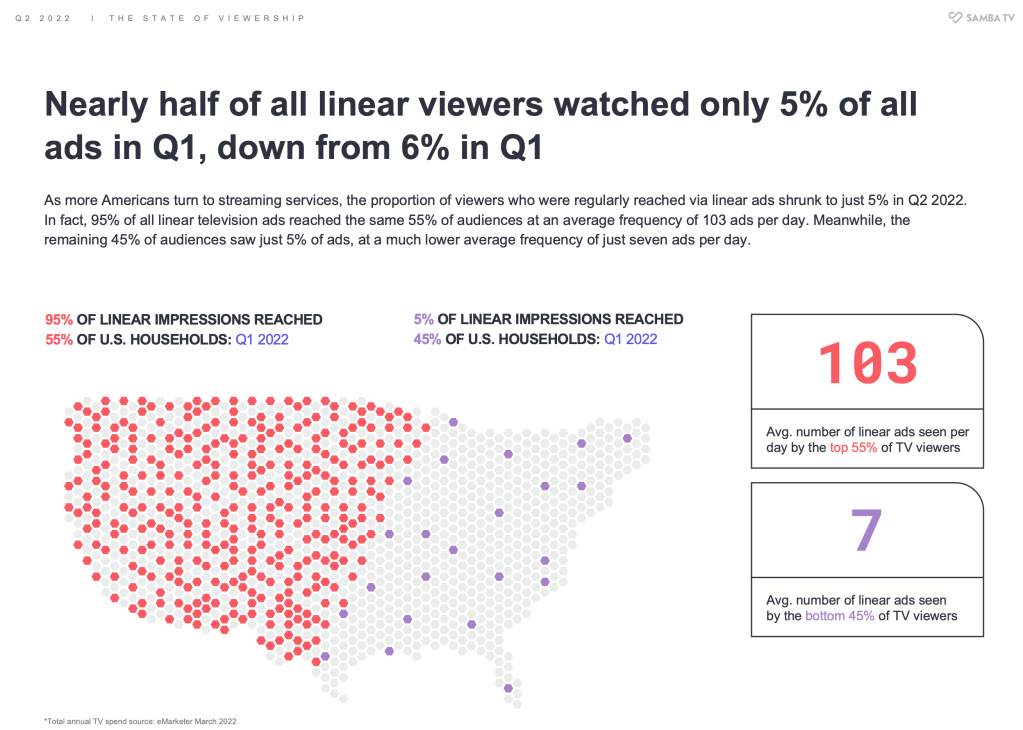Save 50% on a 3-month Digiday+ membership. Ends Dec 5.

This Future of TV Briefing covers the latest in streaming and TV for Digiday+ members and is distributed over email every Wednesday at 10 a.m. ET. More from the series →
This week’s Future of TV Briefing aims to define some of the key terms that can cause confusion when talking about the TV, streaming and digital video industry.
- The future of TV, defined
- Traditional TV’s overexposure issue
The future of TV, defined
A year ago, we published a glossary of key terms that people in the TV, streaming and digital video industry use and, often, misuse. A year later, many of those terms continue to be used and, unfortunately, misused. So we are republishing the guide — with a few new additions for 2022 — that seek to head off any future confusion in conversations about the Future of TV.
CTV
What it stands for: Connected TV
What it refers to: TV screens that are connected to the internet. This can be either a smart TV with its own built-in operating system or a regular, “dumb” TV hooked up to an internet-connected device like an Apple TV box, Roku streaming stick or Chromecast dongle. The point is that CTV concerns the TV as a device through which people stream services like Netflix and Disney+ — it is not synonymous with streaming.
How to use it: To refer to the TV screen as an internet-connected device or to refer to the audiences, programming or ads that are accessed through an internet-connected TV screen. Consider CTV to be the TV industry’s analogue to the mobile industry’s smartphone.
Example sentence: I don’t want to watch “House of Dragons” on my laptop, so I’ll stream it through HBO Max’s CTV app.
OTT
What it stands for: Over the top
What it refers to: The method of distributing TV shows outside of — or, over the top of — a cable box or satellite dish. At least that was the original definition. This acronym was introduced to describe TV networks making their programming available on their websites and other digital properties. Eventually, that included Hulu, which was one of the pioneering streaming services and likely a major reason why OTT has become synonymous with streaming and conflated with CTV.
How to use it: Don’t. Repeat: Do not use this acronym. Please. OTT was fine for a time, but that time has passed. As mentioned above, OTT has become synonymous with streaming, so let’s just say streaming instead. That way our friends and family members will know what the hell we’re talking about.
Example sentence: Remember when we used to say OTT? I’m so glad we all just say streaming now.
FAST
What it stands for: Free, ad-supported streaming TV
What it refers to: Streaming properties that resemble linear TV by carrying channels that air 24/7 based on a set programming schedule, are available for free and feature ads that interrupt the programming.
How to use it: To refer to the subsection of the ad-supported streaming market that mimics pre-DVR broadcast TV. The term FAST can be applied to the services themselves or to individual 24/7 channels that the services carry.
Example sentence: I don’t feel like figuring out what to watch. Just put on a FAST cooking channel so we can start eating.
AVOD
What it stands for: Ad-supported video on demand
What it refers to: Video programming, such as TV shows and movies, that can be accessed at any time, are available either for free or a fee and carry ads that play before, during and/or after the program. AVOD’s distinguishing aspect is that programming is available on demand rather than requiring people to tune in at a given time.
How to use it: With care. Before the rise of FAST services, AVOD was effectively synonymous with ad-supported streaming. Then FAST services came along and split the ad-supported streaming market into two sides — similar to how traditional TV has linear channels and programming available on demand.
But the line between AVOD and FAST is blurring.
A lot of FAST services, such as ViacomCBS’s Pluto TV, have added programming that is available on-demand and carries ads. Meanwhile, originally AVOD services like Amazon’s IMDb TV and Roku’s The Roku Channel have added FAST channels alongside their on-demand programming libraries. In short, only use AVOD when referring to a subsection of the ad-supported streaming market in order to differentiate from the FAST subsection. If the distinction is unnecessary, opt for the umbrella term “ad-supported streaming.”
Example sentence: I’m only interested in buying AVOD inventory because I figure those viewers are more likely to be paying attention when my ad airs.
TV
What it stands for: Television
What it refers to: 1) The large screen(s) in people’s homes through which they watch video programming, ranging from live sports to sitcoms to movies to clips of cats. 2) The video programming that people watch on screens, including, but not limited to, the large screen(s) in their homes.
How to use it: To reflect the convergence between traditional TV and streaming. If a piece of programming can be watched on a TV screen, then it’s TV. Someone who watches a piece of programming or an ad on TV is a TV viewer. An ad that plays on a TV screen is a TV ad.
Admittedly, expanding TV beyond the traditional definition is going to take some time, especially with TikTok having a CTV app so that short-form video can also be considered TV. But if last year’s upfront negotiations are any indication, that broader meaning is gaining traction, especially with digital video platforms like YouTube rivaling Netflix’s TV watch time.
Example sentence: I’m gonna go watch TV now.
Currency
What it refers to: The measurement metric(s) used as the basis for transactions between ad buyers and sellers. Historically, this has referred to Nielsen’s Gross Ratings Point metric that gauges how many people may have seen a brand’s ad on TV, but it can also apply to other types of measurement. For example, since Google sells search ads on a cost-per-click basis, clicks are the currency for search advertising.
How to use it: To refer to measurements strictly when a measurement is the metric dictating how much money is to be exchanged between advertisers and media companies or tech platforms.
Example sentence: I don’t care how many people saw my ad. I care how many people purchased my product after seeing my ad, so let’s use sales lift as the currency for this campaign.
Short-form video
What it refers to: Videos that are 10 minutes or shorter in length and published on vertical video platforms like TikTok, Instagram Reels and YouTube Shorts — for the most part. If that sounds incorrect, that’s understandable. So let’s spend a lot of time talking about the category of videos that are supposed to be concise.
For years, “short-form” referred to videos that were shorter than half-hour TV episodes and typically meant 10-minute-or-less YouTube videos. Then YouTube creators started making 10- to 20-minute-long videos, which begat the term “mid-form video.” Then Snapchat created a market for sub-10-minute-long vertical videos, and TikTok shrunk the market even more with sub-60-second-long vertical videos.
Because nothing can ever be so straightforward, TikTok and Instagram have been blurring the definition of short-form video by extending TikTok video lengths to 10 minutes and Reels to 15 minutes. But rather than saying, “Screw it. It’s all video” and sacrificing any shorthand for delineating among different video formats, let’s stick with the historical 10-minute marker and add the vertical format as a filter
How to use it: With context. If it isn’t already clear, “short-form” is a relative term. A TV or streaming show producer may consider any YouTube video to be short-form, whereas a TikTok creator may consider any YouTube video to be long-form. So rather than use the term “short-form video” on its own, it’s good to cite an example at the same time.
Example sentence: Our short-form video strategy right now is cutting clips from our TV shows and YouTube videos and reformatting them vertically to post to TikTok.
Long-form video
What it refers to: Videos that are more than a minute long and published on horizontal video platforms like YouTube, Facebook and streaming services. Basically any video that doesn’t qualify as short-form video.
As mentioned above, for years long-form video implicitly meant TV-length or longer videos. But then platforms like Vine, Snapchat and TikTok have pulled at the other end of the video spectrum to make 10-minute-long videos feel relatively long. And some TikTok creators even consider plus-60-second-long videos to be long-form. That line of delineation is reinforced by YouTube’s TikTok clone Shorts capping video lengths at 60 seconds, implying that YouTube considers 60 seconds to be the threshold between short-form and not-short-form, which we’ll call long-form (at least for now).
How to use it: With context. Same with short-form video, which is not the same as long-form video.
Example sentence: My long-form video strategy is stitching together a bunch of my TikToks into one video and zooming in to fill the screen horizontally so they look like an episodic TV or YouTube show.
What we’ve heard
“The one thing that was never dealt with in the last [Writers Guild of America] negotiation, because nobody wanted to shut down the business, was they never dealt with the residuals issue. That scares me a little bit. That’ll be [an issue] in 2023.”
— Entertainment executive
Traditional TV’s overexposure issue
Streaming services catch a lot of flak for showing people the same ad over and over again. But traditional TV also has a problem with overexposing audiences to ads.
According to measurement firm Samba TV’s “The State of Viewership” report, the vast majority of ads that aired on traditional TV in the first quarter of 2022 only reached roughly half of U.S. households.

More in Future of TV

Future of TV Briefing: The streaming ad upfront trends, programmatic priorities revealed in Q3 2025 earnings reports
This week’s Future of TV Briefing looks at what TV and streaming companies’ latest quarterly earnings report indicate about the state of the streaming ad market.

Future of TV Briefing: The creator economy needs a new currency for brand deals
This week’s Future of TV Briefing looks at why paying creators based on reach misses the mark and what IAB is doing to clear up the creator-brand currency situation.

Future of TV Briefing: WTF is IAB Tech Lab’s device attestation tactic to combat CTV ad fraud?
This week’s Future of TV Briefing breaks down the CTV ad industry’s new tool for fighting device spoofing.
Ad position: web_bfu




